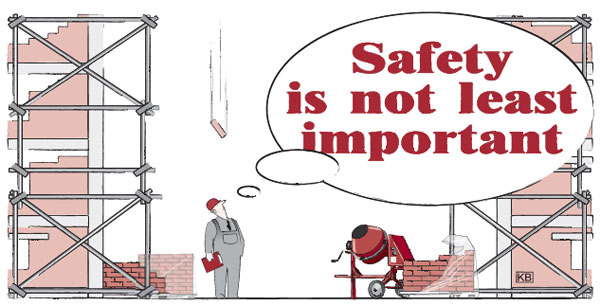Construction sites can be very hazardous indeed as they are areas in which numerous people are working while machinery, tools and building materials are being moved around. To avoid accidents and minimise risks, the place must be carefully managed under health and safety regulations.

Place budowy mogą stać się bardzo niebezpiecznym miejscem pracy, ze względu na to, że pracuje tam wiele ludzi, a jednocześnie uruchamiane są liczne urządzenia, i używa się wielu materiałów. Aby uniknąć wypadków, ważne jest, aby na placu budowy przestrzegano przepisów bezpieczeństwa i higieny pracy.
1. Przeczytaj tekst i dopasuj listę zaniedbań a – d do poszczególnych wypadków przy pracy 1 – 3. Jedno z zaniedbań nie pasuje do żadnego przypadku.
Employers, site managers and workers have to abide by strict regulations to protect themselves and anyone else visiting the building site, and to avoid risks where possible. These laws cover such areas as protective clothing, training, equipment and the general working environment. Below are some examples of breaches of the regulations and their consequences which health and safety investigators are currently looking into.
a) Workers haven’t been protected against the risk of electrocution caused by direct or indirect contact with electricity.
b) Insufficient clearance has been allowed between vehicle traffic routes and passages for pedestrians.
c) The employer hasn’t provided adequate training in the use of personal protective equipment.
d) The structure and condition of work equipment hasn’t been properly maintained to prevent collapse or accidental movements.
Case 1)
A plasterer, who was sub-contracted to work on a large residential building project, was walking along a section of scaffolding boards when the boards gave way and he fell 5 metres to the ground where he was apparently struck by a falling board. He suffered a neck fracture and severe lacerations in the fall.
Case 2)
A young worker died from an electrical shock when he was operating a cement mixer on his first day of work on the site. The cement mixer’s electrical set-up was faulty, with loose wires inside it and with broken plugs. The worker had not been provided with gloves and insulating rubber boots.
Case 3)
A worker was removing debris from the open side of the sixth floor when the ring of his safety belt came off and he fell about 16 meters. The direct cause of this incident was that the worker did not use the safety belt appropriately. He was taken to the hospital, and he died shortly afterwards.
Case 1: ……………… Odpowiedź: wyrażenie d)
Case 2: ……………… Odpowiedź: wyrażenie a)
Case 3: ……………… Odpowiedź: wyrażenie c)
Grammar revision
Przypomnij sobie wiadomości o czasach w języku angielskim (present simple, present continuous, present perfect, past simple, past continuous) z poprzednich lekcji, i wykonaj poniższe zadania.
2. Dopasuj zdania podkreślone w tekście do poniższych sytuacji.
a) czynność niedokonana, odbywająca się w obecnym czasie.
Odpowiedź health and safety investigators are currently looking into
b) czynność zakończona, mająca miejsce w przeszłości.
Odpowiedź He suffered a neck fracture and severe lacerations in the fall
c) czynność ciągła, trwająca w określonym momencie w przeszłości.
Odpowiedź A worker was removing debris from the open side of the sixth floor when the ring of his safety belt came off
d) czynność zakończona, której czas wykonanie nie jest określony, mająca skutki w teraźniejszości.
Odpowiedź The employer hasn’t provided adequate training in the use of personal protective equipment
e) czynność stała, odnosząca się do teraźniejszości.
Odpowiedź These laws cover such areas as protective clothing, training, equipment and the general working environment
4. Zadaj pytanie do brakującego fragmentu zdania:
Vocabulary Revision
5. Dopasuj słowa do poszczególnych kategorii. Skorzystaj z wiadomości przedstawionych w tej i poprzednich lekcjach lub ze słownika.
boring machine, civil servant, conceptual design, cost estimates,
crane, employment/ fixed-term contract, face shield, foreman,
forklift truck, gloves, goggles, headgear, helmets, insulation, lime,
preliminary drawings, reinforcing rod, scaffolding, site supervisor,
pre-cast concrete, formwork, surveyor, tiles, weathering steel
a) formal documentation
b) building materials
c) professions
d) building machinery and equipment
e) safety equipment
6. Uzupenij zdania następującymi wyrazami.
boring machine, crane (x 2) , fixed-term, face shield, preliminary drawings, surveyor, tiles
1. According to the Polish law, an employee cannot be employed on a ……………… fixed-term contract indefinitely.
2. The ……………… crane operators should be aware of how much material can be safely hoisted in each load according to the capacity of the ……………… crane and the weather conditions (e.g. high winds).
3. Once completely assembled underground, the ……………… boring machine and support infrastructure will create twin tunnels, approximately 7.1 kilometres in length .
4. Although welders are not exposed to many dangers, a ……………… face shield or goggles usually provide adequate protection for these workers.
5. When building a residential area, ……………… surveyor are involved to determine the boundaries of private property
6. Approximate construction cost estimates are based on ……………… preliminary drawings
7. The manufacturer specialises in ceramic bathroom ……………… tiles.
Study Tip!
Ważnym narzędziem w nauce języka jest czytanie literatury, co sprzyja rozwojowi zasobu słownictwa, przybliża formy gramatyczne w naturalnym kontekście, oraz poprawia płynność wypowiedzi. Dla osób rozpoczynających naukę wydawane są wersje uproszczone powieści; osoby nieco bardziej zaawansowane mogą podjąć się czytania ich wersji oryginalnych, czasopism, magazynów, itp. Mimo początkowych trudności i konieczności pracy ze słownikiem, warto jest przejść przez ten trudny etap – z każdym rozdziałem czytanie będzie się wydawało łatwiejsze, gdyż przyswoimy już najczęściej pojawiające się wyrazy.
Aneta Kaproń
Szkoła Językowa „Bakałarz”




